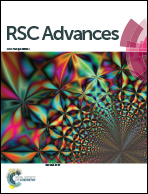Synthesis and study of hybrid hydrogen-bonded bent-core liquid crystal complexes containing C60- and Si-based proton donors†
Abstract
Novel hydrogen-bonded (H-bonded) C60- and Si-based bent-core liquid crystal (LC) complexes containing a bent-shaped proton acceptor and C60- and Si-based single/double armed proton donors were synthesized and mixed to produce hybrid H-bonded LC complexes. The SmCP phases could be introduced in the hybrid LC complexes with a very high C60-based moiety up to 90 mol%. Among our H-bonded LC complexes, the hybrid LC complexes with low amounts of the C60-based moiety (≦24 mol%) possessed the highest spontaneous polarization value (ca. 494 nC cm−2), the widest mesophasic range (40.8 °C) and the lowest saturated electric field (8.8 Vpp μm−1). Under electric fields of modified triangle waveforms, both series of hybrid H-bonded LC complexes displayed an anti-ferroelectric (AF) to a ferroelectric (FE) polar switching as the C60-based moiety increased up to 24–50 mol%. Therefore, the hybrid H-bonded LC complexes containing a broad molar ratio (0–90 mol%) of C60-based moiety revealed a tunable route for the electro-optical applications of C60-based H-bonded liquid crystals.


 Please wait while we load your content...
Please wait while we load your content...